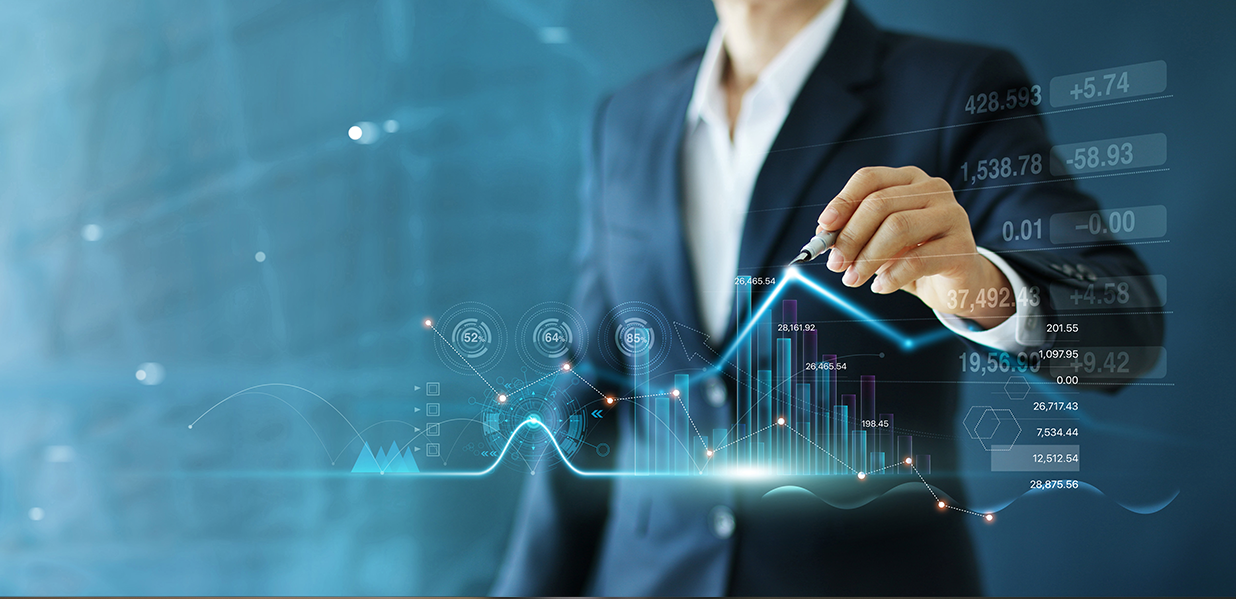The Use Cases of Vision Analytics in Driving Business Growth
As technology continues to evolve, so do the tools at our disposal for extracting insights and driving growth. One such tool that's revolutionizing the business world is Vision Analytics. This game-changing technology is not just a buzzword; it's a catalyst for transformation. In this blog, we'll dive deep into the use cases of Vision Analytics, focusing on how it's reshaping industries and driving businesses to new heights.
Use cases of vision analytics encompass a wide range of applications that extend far beyond the conventional boundaries of data analysis. Vision Analytics is all about harnessing the power of visual data, such as images and videos, to gain valuable insights, make informed decisions, and supercharge business growth.
From enhancing customer experiences and streamlining operations to enabling data-driven decision-making and optimizing marketing strategies, Vision Analytics is the visionary tool that promises to unlock your business's full potential. So, let's embark on this visual journey through the exciting world of Vision Analytics and discover how it's rewriting the rules of business growth.
Use Cases of Vision Analytics Enhancing Customer Experience
Customer Behavior Analysis
- Customer Tracking: Vision analytics can track and analyze customer movements within physical stores to understand how they interact with products and services.
- Demographic Insights: By analyzing facial recognition data, vision analytics can estimate customer demographics, including age, gender, and ethnicity, providing insights into the store's customer base.
- Heatmaps: Generate heatmaps to visualize popular customer pathways and areas of interest, enabling businesses to optimize store layouts for improved customer flow.
- Dwell Time Analysis: Measure the amount of time customers spend at specific product displays or in particular store sections to identify high-traffic areas and areas that need improvement.
- Queue Monitoring: Vision analytics can assess the length and wait times at checkout counters or service areas, allowing businesses to allocate staff resources effectively.
- Reaction Analysis: Analyze customer facial expressions and body language to gauge their emotional reactions to products, services, or interactions, helping businesses adapt their approach accordingly.
Personalized Recommendations
- Visual Product Matching: Vision analytics can analyze images of products customers are interested in and recommend visually similar items, enhancing the accuracy of personalized recommendations.
- Image Recognition: Implement image recognition to identify specific products or objects in customer photos or videos, enabling tailored product suggestions.
- Real-time Personalization: Utilize vision analytics to update recommendations in real time based on the customer's current browsing or shopping session, improving relevance.
- Cross-Channel Personalization: Extend personalized recommendations across various customer touchpoints, including websites, mobile apps, email marketing, and in-store displays, creating a consistent and engaging experience.
- Behavior-Based Recommendations: Combine visual data with browsing and purchase history to create personalized recommendations that align with a customer's preferences and behaviors.
- A/B Testing: Continuously refine recommendation algorithms through A/B testing to optimize click-through rates and conversion rates based on visual data.
Virtual Try-On and Augmented Reality
- Virtual Fitting Rooms: Employ virtual try-on experiences for fashion and accessories, allowing customers to see how clothing, eyewear, or makeup will look on them through their device's camera.
- AR Product Visualization: Use augmented reality to project virtual products into a customer's real-world environment, enhancing their understanding of how products fit or appear.
- Interactive Product Exploration: Enable customers to interact with products in 3D or AR, fostering engagement and improving their decision-making process.
- Customization: Allow customers to personalize and customize products virtually, such as trying different colors or configurations before making a purchase decision.
- Interactive Showrooming: Implement AR showrooms where customers can explore products in an interactive, immersive environment, even if they're shopping online.
- Real-time Feedback: Use AR to provide real-time feedback on products, such as fitness equipment or fashion items, to help customers make informed choices.
Inventory Management and Product Placement
- Visual Inventory Tracking: Employ vision analytics to monitor inventory levels and identify low-stock or overstock situations, ensuring products are readily available to meet customer demands.
- Planogram Optimization: Use visual data to optimize store layouts (planograms) based on customer traffic and behavior patterns, ensuring products are strategically placed for maximum visibility.
- Dynamic Pricing Displays: Implement electronic shelf labels with vision analytics capabilities to display dynamic pricing information and product details, improving the shopping experience.
- Cross-Sell and Upsell Displays: Utilize vision analytics to identify complementary products and automatically trigger interactive displays or recommendations that encourage cross-selling and upselling.
- Product Recognition for Customers: Enable customers to use their mobile devices to scan and receive detailed information about products, including reviews and pricing, enhancing their shopping experience.
- Inventory Heatmaps: Generate heatmaps to visualize product popularity and adjust inventory placement accordingly to improve product availability and customer satisfaction.
Uses Cases of Vision Analytics In Improving Operational Efficiency
Quality Control and Defect Detection
- Automated Inspection: Vision analytics can automate the inspection process by examining products or components for defects, ensuring a consistent and high-quality output.
- Defect Classification: It can classify defects based on predefined criteria, providing detailed information to operators for prompt corrective actions.
- Real-time Quality Monitoring: Vision analytics systems can monitor the quality of products in real-time, immediately flagging any deviations from standards or specifications.
- Reduced Scrap and Rework: By detecting defects early in the manufacturing process, vision analytics can significantly reduce scrap and rework costs, improving overall operational efficiency.
- Statistical Process Control: Vision analytics can be integrated with statistical process control (SPC) techniques to continuously monitor and adjust production processes for consistent quality.
- Data for Process Improvement: Collect and analyze data on defects and their causes to identify areas for process improvement, leading to enhanced product quality and efficiency.
Supply Chain Optimization
- Demand Forecasting: Vision analytics can analyze historical sales data and market trends to provide accurate demand forecasts, helping optimize inventory levels and reduce carrying costs.
- Inventory Management: It can monitor inventory levels in real-time and trigger automatic reorder points to ensure the timely availability of products while minimizing overstock.
- Supplier Performance Monitoring: Evaluate supplier performance by tracking the quality and timeliness of deliveries, enabling informed decisions about supplier relationships.
- Route Optimization: Vision analytics can optimize shipping routes and transportation logistics, reducing fuel costs and delivery times.
- Warehouse Automation: Employ vision analytics for automated warehouse management, including efficient picking, packing, and sorting of products.
- Quality Assurance in the Supply Chain: Ensure consistent product quality across the supply chain by using vision analytics to inspect incoming materials and components.
Predictive Maintenance
- Equipment Health Monitoring: Vision analytics can continuously monitor the condition of machinery and equipment, detecting early signs of wear or potential failures.
- Anomaly Detection: Identify anomalies in equipment performance, such as irregular vibrations or temperature fluctuations, to predict and prevent breakdowns.
- Predictive Analytics: Utilize historical equipment data and maintenance records to create predictive maintenance models that schedule maintenance tasks before critical failures occur.
- Downtime Reduction: Implementing predictive maintenance based on vision analytics can significantly reduce unplanned downtime, resulting in increased operational efficiency and productivity.
- Cost Savings: By addressing maintenance needs proactively, businesses can save on repair costs, replacement parts, and lost production time.
- Condition-based Maintenance: Transition from a time-based maintenance approach to a condition-based one, where maintenance is performed when needed, optimizing equipment uptime.
Employee Productivity and Safety
- Safety Compliance: Vision analytics can monitor employee adherence to safety protocols and detect unsafe behaviors or situations, reducing workplace accidents.
- Ergonomics Analysis: Analyze employee movements and posture to identify ergonomic issues, improving worker comfort and productivity.
- Workforce Productivity Metrics: Measure employee productivity by tracking task completion times, identifying bottlenecks, and optimizing work processes.
- Training and Assistance: Provide real-time guidance and training to employees using augmented reality (AR) overlays, improving task accuracy and efficiency.
- Security and Access Control: Utilize facial recognition and access control systems to ensure only authorized personnel have access to restricted areas.
- Employee Well-being: Use vision analytics to monitor environmental conditions, such as temperature and air quality, to ensure a comfortable and productive work environment.
Use Cases of Vision Analytics In Data-Driven Decision-Making
Real-time Analytics
- Live Monitoring: Vision analytics enables real-time monitoring of various processes, such as manufacturing lines, traffic, or customer interactions, providing immediate insights into ongoing operations.
- Performance Metrics: Continuously track key performance indicators (KPIs) using vision analytics to make data-driven decisions on the fly, responding quickly to changing conditions.
- Alerts and Notifications: Set up automated alerts and notifications based on visual data anomalies or threshold breaches, allowing for timely intervention and decision-making.
- Operational Adjustments: Use real-time visual data to make adjustments to resource allocation, staffing, and logistics to optimize operations and minimize disruptions.
- Customer Insights: Analyze real-time customer behavior data from in-store cameras or online interactions to tailor marketing efforts and enhance the customer experience immediately.
- Supply Chain Visibility: Gain visibility into the supply chain by tracking the movement and condition of goods in real time, helping with inventory management and order fulfillment.
Market Research and Competitive Analysis
- Customer Behavior Analysis: Employ vision analytics to gather insights into customer preferences, sentiment, and interactions with products and services, aiding in market segmentation and targeting.
- Competitor Tracking: Monitor competitor activities, including store layouts, pricing changes, and product launches, to inform competitive strategies.
- Visual Market Trends: Analyze visual data from social media, websites, and online platforms to identify emerging market trends and consumer sentiment.
- Image Recognition for Brand Mentions: Use image recognition to track brand mentions and product placement in user-generated content, helping assess brand perception.
- Retail Shelf Analytics: Analyze product placement and shelf space allocation in retail environments to understand market dynamics and optimize product visibility.
- Consumer Surveys and Feedback: Use facial recognition and sentiment analysis to gauge consumer reactions to products, advertisements, or marketing campaigns, guiding decision-making.
Fraud Detection and Security
- Anomaly Detection: Implement vision analytics to detect unusual activities or behaviors, such as unauthorized access or suspicious movements, in real-time.
- Facial Recognition for Access Control: Use facial recognition technology to ensure only authorized personnel gain access to secure areas, enhancing security measures.
- Identification of Security Threats: Analyze surveillance footage to identify potential security threats, intruders, or anomalies that require immediate action.
- Transaction Verification: In financial services, use vision analytics to verify transactions and detect fraudulent activities based on visual data patterns.
- Authentication and Identity Verification: Leverage facial recognition and biometric data for secure user authentication and identity verification.
- Privacy Compliance: Ensure that vision analytics solutions adhere to privacy regulations and guidelines while enhancing security measures.
Compliance and Regulatory Requirements
- Data Privacy Compliance: Implement privacy-preserving techniques within vision analytics to comply with data protection regulations like GDPR and CCPA.
- Audit Trails: Maintain comprehensive audit trails of visual data processing and decision-making processes to demonstrate compliance with regulatory requirements.
- Ethical AI Practices: Adhere to ethical AI principles when using vision analytics, including fairness, transparency, and accountability, to meet regulatory standards.
- Documentation and Reporting: Generate reports and documentation detailing the use of vision analytics in compliance with specific industry regulations and standards.
- Regulatory Monitoring: Continuously monitor and adapt vision analytics processes to ensure alignment with evolving compliance and regulatory requirements.
- Legal and Compliance Risk Mitigation: Use vision analytics to identify and mitigate potential legal or compliance risks, such as data breaches or non-compliance issues.
Use Cases of Vision Analytics In Optimizing Marketing and Sales
Real-time Analytics
- Live Monitoring: Vision analytics enables real-time monitoring of various processes, such as manufacturing lines, traffic, or customer interactions, providing immediate insights into ongoing operations.
- Performance Metrics: Continuously track key performance indicators (KPIs) using vision analytics to make data-driven decisions on the fly, responding quickly to changing conditions.
- Alerts and Notifications: Set up automated alerts and notifications based on visual data anomalies or threshold breaches, allowing for timely intervention and decision-making.
- Operational Adjustments: Use real-time visual data to make adjustments to resource allocation, staffing, and logistics to optimize operations and minimize disruptions.
- Customer Insights: Analyze real-time customer behavior data from in-store cameras or online interactions to tailor marketing efforts and enhance the customer experience immediately.
- Supply Chain Visibility: Gain visibility into the supply chain by tracking the movement and condition of goods in real time, helping with inventory management and order fulfillment.
Market Research and Competitive Analysis
- Customer Behavior Analysis: Employ vision analytics to gather insights into customer preferences, sentiment, and interactions with products and services, aiding in market segmentation and targeting.
- Visual Market Trends: Analyze visual data from social media, websites, and online platforms to identify emerging market trends and consumer sentiment.
- Image Recognition for Brand Mentions: Use image recognition to track brand mentions and product placement in user-generated content, helping assess brand perception.
- Retail Shelf Analytics: Analyze product placement and shelf space allocation in retail environments to understand market dynamics and optimize product visibility.
- Consumer Surveys and Feedback: Use facial recognition and sentiment analysis to gauge consumer reactions to products, advertisements, or marketing campaigns, guiding decision-making.
Fraud Detection and Security
- Anomaly Detection: Implement vision analytics to detect unusual activities or behaviors, such as unauthorized access or suspicious movements, in real-time.
- Facial Recognition for Access Control: Use facial recognition technology to ensure only authorized personnel gain access to secure areas, enhancing security measures.
- Identification of Security Threats: Analyze surveillance footage to identify potential security threats, intruders, or anomalies that require immediate action.
- Transaction Verification: In financial services, use vision analytics to verify transactions and detect fraudulent activities based on visual data patterns.
- Authentication and Identity Verification: Leverage facial recognition and biometric data for secure user authentication and identity verification.
- Privacy Compliance: Ensure that vision analytics solutions adhere to privacy regulations and guidelines while enhancing security measures.
Compliance and Regulatory Requirements
- Data Privacy Compliance: Implement privacy-preserving techniques within vision analytics to comply with data protection regulations like GDPR and CCPA.
- Audit Trails: Maintain comprehensive audit trails of visual data processing and decision-making processes to demonstrate compliance with regulatory requirements.
- Ethical AI Practices: Adhere to ethical AI principles when using vision analytics, including fairness, transparency, and accountability, to meet regulatory standards.
- Documentation and Reporting: Generate reports and documentation detailing the use of vision analytics in compliance with specific industry regulations and standards.
- Regulatory Monitoring: Continuously monitor and adapt vision analytics processes to ensure alignment with evolving compliance and regulatory requirements.
- Legal and Compliance Risk Mitigation: Use vision analytics to identify and mitigate potential legal or compliance risks, such as data breaches or non-compliance issues.
Case Studies on Use Cases of Vision Analytics
Case Study 1: Retail - Optimizing Store Layouts
Industry: Retail
Challenge: Improving store layout to enhance customer experience and boost sales.
Solution: A major retail chain implemented vision analytics to track customer movements within their stores. Cameras were strategically placed to capture shopper traffic patterns. The collected data was then analyzed to optimize store layouts, product placement, and aisle design.
Results:
- Increased in-store sales by 15%.
- Improved customer satisfaction due to a more efficient and enjoyable shopping experience.
- Reduced congestion and bottlenecks in high-traffic areas.
Lessons Learned and Best Practices
- Ensure data privacy compliance when monitoring customer behavior.
- Continuously analyze and adjust store layouts based on changing customer preferences.
- Regularly update and maintain the vision analytics system for accuracy.
- Consider implementing interactive displays and personalized recommendations to further enhance the shopping experience.
Case Study 2: Healthcare - Predictive Maintenance for Medical Equipment
Industry: Healthcare
Challenge: Minimizing downtime and ensuring the reliability of critical medical devices.
Solution: A large hospital network adopted vision analytics for predictive maintenance of medical equipment. Cameras were installed to monitor key devices like MRI machines and CT scanners. Advanced algorithms analyzed visual data and equipment parameters to predict maintenance needs.
Results:
- Reduced equipment downtime by 25%.
- Saved over $1 million annually in maintenance costs.
- Improved patient care by ensuring timely access to vital medical equipment.
Lessons Learned and Best Practices
- Collaborate with equipment manufacturers for data integration and support.
- Implement a preventive maintenance schedule based on predictive analytics.
- Provide training for staff to respond effectively to maintenance alerts.
- Continuously update predictive models with new data for increased accuracy.
Case Study 3: Manufacturing - Quality Control in Electronics
Industry: Manufacturing (Electronics)
Challenge: Ensuring the quality of electronic components in high-speed production.
Solution: An electronics manufacturer integrated vision analytics into its production line. High-speed cameras captured images of electronic components, and machine learning algorithms identified defects in real-time. Defective components were automatically sorted out.
Results:
- Reduced defect rates by 30%.
- Increased production efficiency by minimizing the need for manual inspection.
- Enhanced product quality and customer satisfaction.
Lessons Learned and Best Practices
- Invest in high-resolution, high-speed cameras for accurate defect detection.
- Collaborate with data scientists to fine-tune machine learning models.
- Implement real-time alerts for immediate action on defective components.
- Regularly calibrate and maintain cameras and inspection equipment.
Conclusion
In conclusion, the use cases of vision analytics have emerged as powerful tools for driving business growth across a wide range of industries. This transformative technology harnesses the power of computer vision, machine learning, and data analytics to provide valuable insights and enhance decision-making processes. The use cases of vision analytics has yielded tangible benefits, contributing to increased efficiency, enhanced customer experiences, and improved bottom-line results.
In various sectors, including retail, healthcare, manufacturing, finance, and transportation, vision analytics has demonstrated its capacity to optimize operations, boost productivity, and deliver more personalized and efficient services.
In a data-driven era, the role of vision analytics in driving business growth is undeniable. It empowers organizations to unlock hidden insights, optimize processes, and adapt to evolving customer needs and market dynamics. While realizing the full potential of vision analytics requires careful planning, ongoing maintenance, and adherence to privacy and ethical considerations, the rewards in terms of growth, efficiency, and innovation are substantial.
As technology continues to advance, we can anticipate even more impactful use cases and transformative opportunities for vision analytics in the years to come, further driving business growth and innovation across industries.
Why Choose Us?
Choose Infiniticube – Your Visionary Partner for Business Growth
We understand that one size does not fit all. Your business is unique, and so are your challenges and opportunities. We specialize in crafting customized vision analytics solutions that align perfectly with your objectives and industry demands.
We are at the forefront of technological innovation. Our solutions leverage the latest advancements in computer vision, artificial intelligence, and deep learning, ensuring you stay ahead of the curve.
From consultation and data collection to model development, deployment, and ongoing support, we provide comprehensive end-to-end services. You don't need to navigate the complexities alone – we're with you every step of the way.
Contact us today to discover how our cutting-edge vision analytics solutions can propel your business forward. Don't miss out on the opportunity to optimize operations, enhance customer experiences, and stay ahead of the competition.
Need more specifications about your project or want to discuss your requirements in detail, schedule a call to meet with our expert.
 June 27, 2025
June 27, 2025
 Balbir Kumar Singh
Balbir Kumar Singh
 0
0
 June 13, 2025
June 13, 2025
 Balbir Kumar Singh
Balbir Kumar Singh
 0
0
 June 27, 2025
June 27, 2025
 Balbir Kumar Singh
Balbir Kumar Singh
 0
0
 June 13, 2025
June 13, 2025
 Balbir Kumar Singh
Balbir Kumar Singh
 0
0
 June 27, 2025
June 27, 2025
 Balbir Kumar Singh
Balbir Kumar Singh
 0
0
 June 13, 2025
June 13, 2025
 Balbir Kumar Singh
Balbir Kumar Singh
 0
0









Leave a Reply